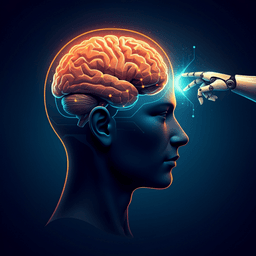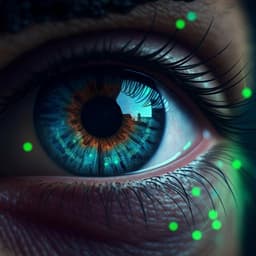
Engineering and Technology
Adaptative machine vision with microsecond-level accurate perception beyond human retina
L. Li, S. Li, et al.
Discover how innovative avalanche tuning as feedforward inhibition in a bionic 2D transistor allows for ultra-fast visual adaptation. This remarkable research carried out by authors including Ling Li and Shasha Li introduces an advanced machine vision system that boasts microsecond-level adaptation and unprecedented image recognition capabilities.
~3 min • Beginner • English
Introduction
Human visual adaptation relies on neural circuit motifs in the retina where photoreceptors (rods and cones) communicate with horizontal and bipolar cells. Classical feedback inhibition via horizontal neurons modulates sensitivity but introduces significant time hysteresis, leading to slow adaptation that can pose hazards (e.g., sudden brightness changes causing impaired perception). Machine vision, typically powered by convolutional neural networks, achieves high recognition accuracy but struggles under varying brightness without complex preprocessing and circuitry. Existing bio-inspired 2D visual sensors emulate adaptation mainly through feedback mechanisms such as charge trapping/detrapping, which are slow (minutes) and often require external gate reconfiguration. The study aims to realize a faster, more predictive visual adaptation by introducing feedforward inhibition using avalanche tuning in a 2D bionic transistor, enabling microsecond-level adaptation and enhancing machine vision performance under rapidly changing illumination.
Literature Review
Prior 2D bionic vision sensors have demonstrated photopic and scotopic adaptation by mechanisms including charge trapping/detrapping in bilayer MoS₂ transistors under gate modulation (slow, minutes, manual configuration), photo-thermoelectric effects in 1D devices (limited to photopic), and interfacial-defect-mediated feedback inhibition in ReS₂/NbSe₂ devices (still prolonged). Most reported systems emulate adaptation via feedback inhibition (trap/detrap) akin to retinal processes, inherently limiting speed. Neural circuit literature distinguishes feedforward inhibition (faster, predictive) from feedback inhibition (slower), suggesting a route to accelerate adaptation if implemented in devices. Avalanche photodetectors in various 2D materials (e.g., MoS₂, WSe₂, InSe, black phosphorus, Bi2O2Se) provide high gain and bandwidth, indicating a technological basis for fast, sensitive light detection; however, their integration for bio-inspired feedforward adaptation had not been employed.
Methodology
Device architecture: A van der Waals heterostructure field-effect transistor comprising an ultrathin MoS₂ transport channel (~3.93 nm) and a top WSe₂ gate (~3.04 nm) on 300 nm SiO₂/Si. The MoS₂/WSe₂ interface forms a depletion region and built-in electric field tunable by top-gate voltage to control switching and avalanche behavior.
Fabrication: Few-layer MoS₂ and WSe₂ mechanically exfoliated and stacked using PVA/PDMS-assisted dry transfer. Ti/Au (50/50 nm) electrodes patterned by UV maskless lithography and e-beam evaporation. Annealed 2 h at 150 °C in N₂.
Characterization: Cross-sectional HRTEM and STEM-EDS confirm clean vdW interface and layer composition. Kelvin probe force microscopy measured work functions (WSe₂: 4.81 eV; MoS₂: 4.68 eV) and surface potential difference (~1.35 eV), indicating a built-in field from MoS₂ to WSe₂. Electrical I–V shows diode-like behavior with rectification ratio ~10⁴ and near-unity ideality.
Avalanche operation: Acting as a JFET, the device transitions from linear to saturation to avalanche as V_DS increases beyond breakdown V_BR. Gate voltage V_GS modulates V_BR and multiplication factor. At V_DS = −3 V biasing conditions, V_b ≈ 5.48 V and multiplication factor up to ~5.29 × 10⁶ (as reported). Noise spectral density measured via FFT of dark current; avalanche reduces S_n markedly, improving sensitivity.
Modeling and simulation: TCAD used to map electric field and impact ionization rate versus V_DS and V_GS, showing pinch-off evolution, field strengthening, and ionization localization consistent with avalanche onset and gate/bias control. Light-dependent simulations examine effective field and ionization under varied illumination.
Photoresponse measurements: 635 nm laser excitation (spot ~3 mm). Dynamic response assessed with an electric shutter and oscilloscope; rise/fall times defined between 10–90% levels. Frequency response measured to extract −3 dB bandwidth in weak/strong light and under positive/negative photoconductivity regimes.
Machine vision integration: A three-layer CNN trained on 10,000 MNIST images at varied brightness levels; image brightness provided as an explicit additional input parameter. Performance evaluated under brightness decrease/increase and combined with the bionic transistor to form an adaptive vision system; recognition accuracy and adaptation time recorded (e.g., test on digit “7” with controlled illumination changes).
Key Findings
- Feedforward inhibition via avalanche tuning in a MoS₂/WSe₂ bionic transistor enables ultra-fast visual adaptation with microsecond accuracy, over 10⁴× faster than human retina and prior bionic sensors.
- Device performance: breakdown voltage ~5.48 V (under specified gate/drain conditions); avalanche multiplication factor up to ~5.29 × 10⁶; diode rectification ratio ~10⁴; substantial noise reduction in avalanche (S_n from ~2.41 × 10⁻⁴ to ~1.83 × 10⁻¹² Hz⁻¹).
- Light-intensity dependence: transition from positive photoconductivity in linear/saturation to negative photoconductivity in avalanche (ionization) region; photocurrent increases then decreases with increasing light at V_DS = 7.5 V (from +5.1 μA to −2.2 μA), emulating inhibitory adaptation to prevent overstimulation.
- Responsivity spans orders of magnitude in avalanche regime with sign reversal, from ~7.6 × 10⁻¹⁰ to ~1.0 × 10¹⁰ A/W (saturation region ~1.58–5 A/W). Reported avalanche gain decreases with increasing light, from ~1.5 × 10⁵ to ~8.
- Dynamic response: before breakdown, response 1–5 ms (trap-limited); in avalanche, response as fast as ~85 μs (trap filling by avalanche carriers). Visual adaptation saturation times: ~108 μs (scotopic) and ~268 μs (photopic) at 500 Hz.
- Bandwidth: −3 dB bandwidth up to ~10.5 kHz (weak light) and ~3.7 kHz (strong light), surpassing retinal (~500 Hz) and many JFET devices.
- High-frequency operation: reliable scotopic and photopic adaptation at 6 kHz and 3 kHz, respectively, with current change ratios CCR ≈ 2.62 (excitation, scotopic) and 0.47 (inhibition, photopic) and minimal degradation at higher frequencies.
- Machine vision: baseline CNN robust to brightness decrease (accuracy ~93.3%) but accuracy drops under brightness increase; ±20% brightness yields ~83.3% accuracy. Combining the bionic transistor with CNN yields rapid adaptation and recognition: e.g., ~89.3% accuracy in 9.5 μs (scotopic) and ~92.8% in 174 μs (photopic) in a representative test; overall claim of >98% precision in both dim and bright conditions for the adaptive system.
Discussion
By replacing slow feedback inhibition (trap-mediated) with a feedforward inhibition mechanism realized through avalanche tuning, the device emulates retinal-like adaptation while dramatically accelerating it into the microsecond regime. The light-intensity-dependent switching between avalanche-dominated sensing (high sensitivity, akin to rods) and photoconductive response (lower sensitivity, akin to cones) mirrors biological photoreceptor alternation across scotopic and photopic conditions. The sign-reversible responsivity and large gain range provide intrinsic contrast management, preventing overexposure-induced overstimulation. The high bandwidth and stable high-frequency adaptation indicate suitability for rapidly changing illumination scenarios where conventional sensors or neural post-processing would lag. Integrating this fast, adaptive front end with a CNN reduces reliance on complex preprocessing and maintains recognition robustness across brightness variations, addressing a key challenge in machine vision and opening paths for safer, real-time applications (e.g., autonomous driving, surveillance).
Conclusion
The study demonstrates a bionic MoS₂/WSe₂ avalanche transistor that implements a feedforward inhibition strategy to achieve ultra-fast, high-frequency visual adaptation beyond human retinal performance. The device exhibits large avalanche gain, broad and sign-reversible responsivity, reduced noise in avalanche, and high −3 dB bandwidth, enabling rapid scotopic and photopic adaptation at microsecond timescales and kilohertz frequencies. When coupled with a CNN, the system achieves rapid adaptation and high recognition accuracy across varying brightness, with claims of >98% precision in both dim and bright conditions. Future work could extend to broader datasets and real-world imaging scenarios, wavelength diversity, pixel-array integration for imaging, and on-chip co-design with neuromorphic processors to further simplify system complexity and enhance robustness.
Limitations
Explicit limitations are not extensively discussed. Experiments were performed under controlled laboratory conditions (single-wavelength 635 nm illumination, device-level tests) and recognition demonstrations used MNIST digits with brightness variation; comprehensive real-world imaging evaluations and multi-spectral performance were not reported, which may affect generalizability to diverse environments. Some reported quantitative metrics in different sections show minor inconsistencies, warranting further standardized benchmarking.
Related Publications
Explore these studies to deepen your understanding of the subject.







